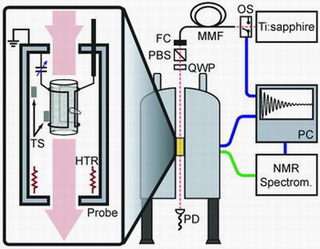May 17, 2007 feature
Transferring spin polarization from a gas to a solid

Some time ago, scientists learned to polarize noble gases so that when they were inhaled, an MRI machine could take pictures of the lungs. But if other types of elements could be polarized as well, the potential benefits to the medical community could be even greater.
“Right now,” William Happer tells PhysOrg.com, “most MRIs read protons in water and fat, and those signals are very weakly polarized. If you have nearly the same number of spin up protons as spin down, you might not see anything.”
Happer, along with Brian Patton, one of his students at Princeton University, and Kiyoshi Ishikawa, a visiting professor from Japan, decided to see if there was a way to transfer spin from easily polarized atoms to those that may be harder to change.
“There are many other things in the body, from Carbon 13 to sodium chloride in the blood that could provide clues to diseases,” continues Happer. “Polarizing the nuclei of these elements could make MRIs more effective.”
The results of their experiment, which showed that it is possible to transfer spin polarization from a gas to a solid, are published in Physical Review Letters with the title, “Spin Transfer from an Optically Pumped Alkali Vapor to a Solid.”
One of the requirements for a better MRI picture is a long relaxation time. “The longer these stay the same,” explains Patton, “the better the picture. But there are some elements that are hard to work with.” Alkali metals, like the cesium used in the experiment, are easy to polarize. But they are not particularly useful for medical applications. Lithium, though, Patton points out, is a difficult metal that offers great potential for the medical field. “If we could use this technique to polarize lithium nuclei,” he continues, “it would open new possibilities.”
So far, the experiment has succeeded in transferring the spin from a cesium electron to a cesium nucleus. “The trick,” Patton explains, “is to transfer the spin polarization from the electron of a vapor to the nucleus of a solid. This is what we’ve done with cesium.”
“This is an interesting discovery,” adds Happer, “because it shows the potential to transfer spin polarization not only from the same type of atom to another of the same atom, but it also provides a way that we might be able to transfer the polarization from one atom to an atom from a different element.” Patton thinks it might even work to transfer polarization from an alkali metal vapor to the nucleus of a solid, but difficult, metal.
Spin polarization transfer does offer some challenges to overcome. “At lower magnetic fields, this should hypothetically work flawlessly,” says Patton. “However, you can’t perform nuclear magnetic resonance (which is used by MRIs) at these low fields. We realized that when we switched to a higher magnetic field, spin polarization wasn’t so easy any more.”
So how did Happer, Patton and Ishikawa solve this problem? “Well,” admits Patton, “it’s still hard. Essentially, we have to rely on different physical mechanisms to polarize the nuclei. We looked to atomic clocks to get a better idea of what we could do.”
If this concept works as expected between electrons and nuclei of different elements, it could mean breakthroughs for more than MRIs. Spectroscopy, fundamental physics knowledge and other applications could result from this discovery. “It looks very good right now,” says Happer. “It may take a few years to see what will pan out, but we think it has a good chance.”
Patton is even more optimistic: “There is a myriad of applications for this work. We’re so close to the beginning that the field is wide open.”
Copyright 2007 PhysOrg.com.
All rights reserved. This material may not be published, broadcast, rewritten or redistributed in whole or part without the express written permission of PhysOrg.com.




















